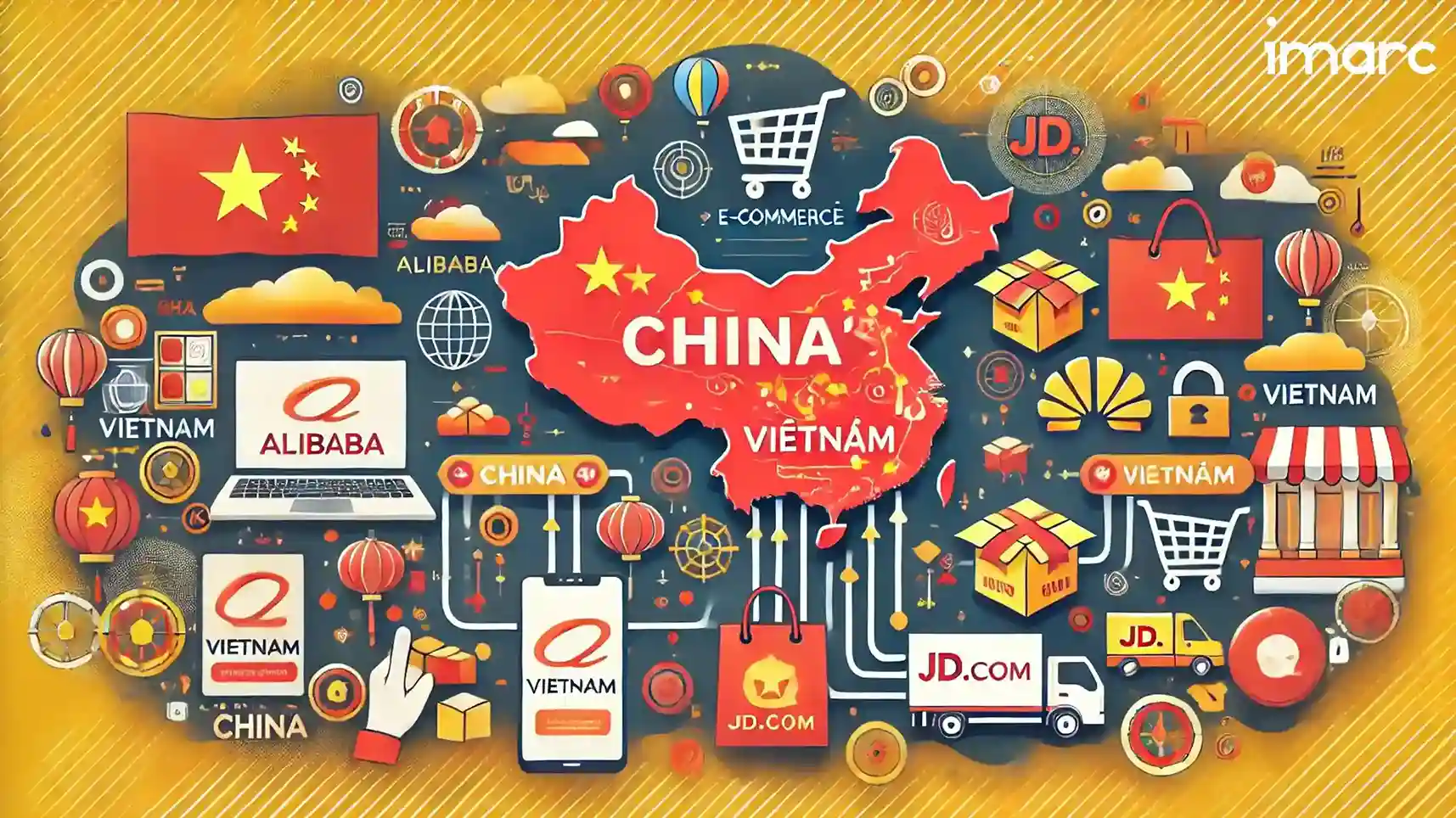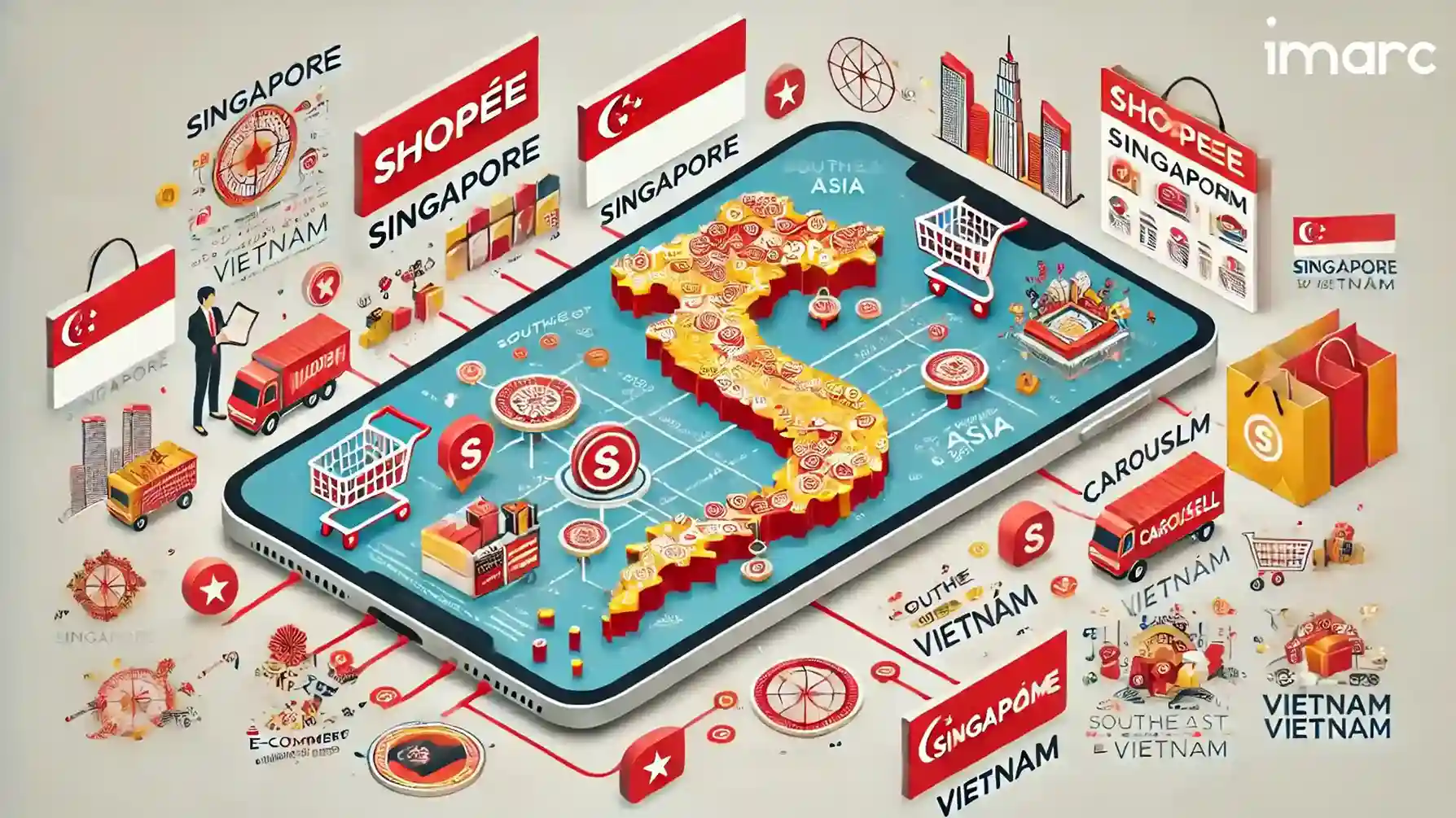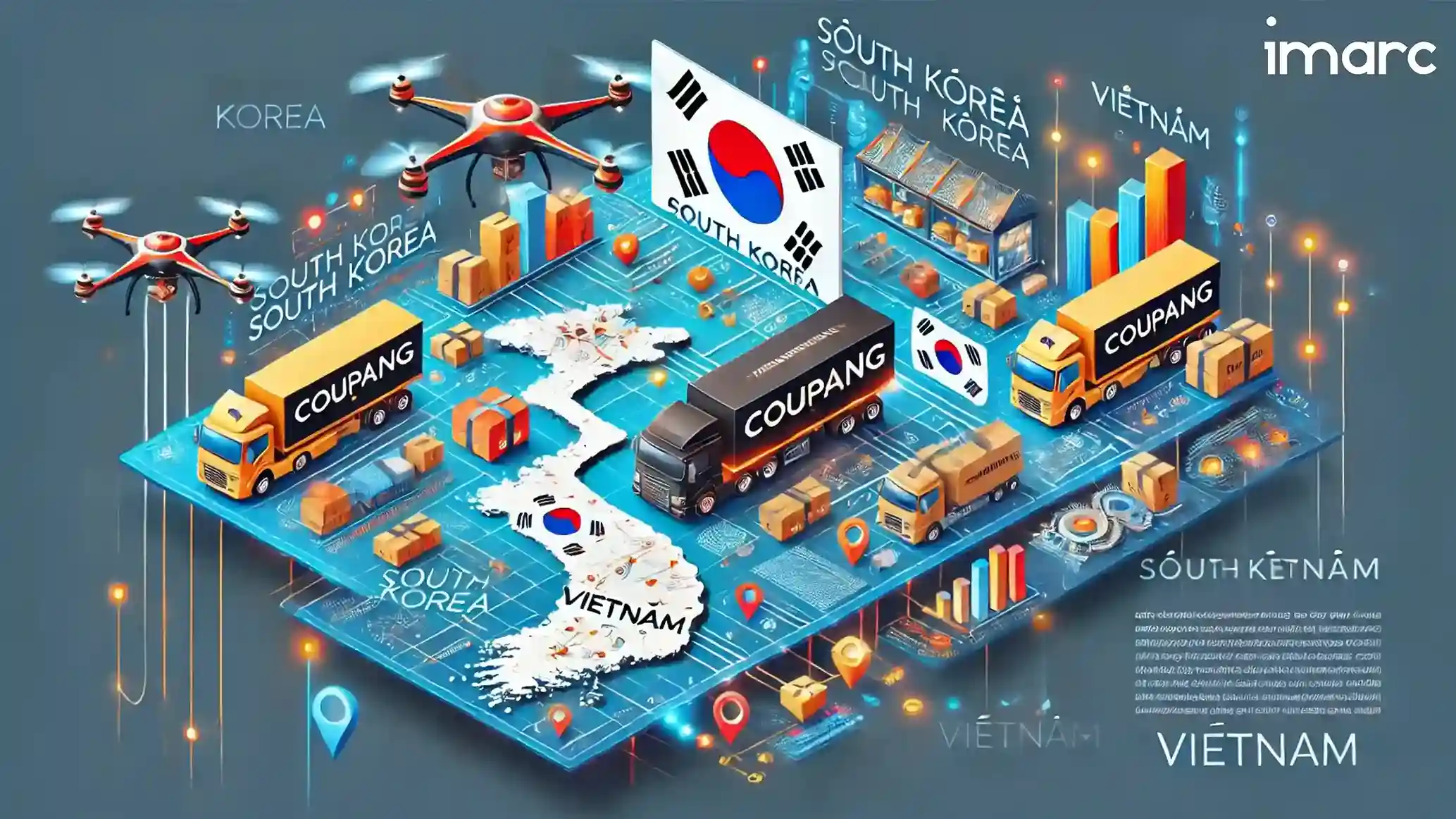Vietnam's E-Commerce Boom: A Regional Powerhouse in the Making

E-commerce has increasingly become a transformative force, revolutionizing several industries across the world. It is unlocking new market opportunities in emerging economies, enabling small businesses to grow and empower consumers with enhanced preferability and convenience. According to a recent study by IMARC, the global e-commerce market size is valued at US$ 26.8 Trillion in 2024 and is projected to reach US$ 214.5 Trillion by 2033, exhibiting a CAGR of 25.83% from 2025-2033. From established giants in the United States and Europe to fast-paced markets in Asia, the e-commerce revolution is creating a competitive marketplace that transcends geographical boundaries. Vietnam stands out as a key force in this global trend, showcasing the potential of e-commerce to drive national economic transformation. The country’s e-commerce industry is witnessing tremendous growth, driven by new markets and growth opportunities in established markets.
With favorable regulatory conditions, expanding foreign investments, and enhanced internet accessibility, Vietnam’s e-commerce ecosystem is poised to witness sustained expansion, transforming it into a regional powerhouse in the digital economy. E-commerce accounts for over 60% of Vietnam’s digital economy, while a significant chunk of the remaining 40% share is captured by ride-hailing and online media. In addition, the country’s digital economy is estimated to reach USD 220 Billion by 2030, portraying ample opportunities for global investors. Projections indicate that Ho Chi Minh City and Hanoi will develop to become significant hubs. The most popular digital platforms in the country include Shopee, TikTok Shop, Lazada, Tiki, and Sendo. New Chinese platforms including Temu and Shein are also striving to grab a significant market share in the country. According to the Ministry of Information and Communication data, there are:
- 78.5 million users on Shopee
- 14.8 million users on Lazada
- 14.1 million users on Tiki
- 12.7 million users on Good Market (Vietnam)
The volume of visitors highlights the dominance of foreign e-commerce platforms in the market.
Vietnam Set to Lead Southeast Asia’s E-Commerce Revolution – Industry Highlights:
- Vietnam is recognized as one of the most conducive legal environments for e-commerce in the Association of Southeast Asian Nations (ASEAN) region. The country has implemented five out of six pieces of legislation that are aimed at e-commerce activity regulation. This sector has remarkably influenced the recent expansion of the transportation, distribution, and fulfillment services ecosystem.
- According to a survey by Facebook and Bain & Company, by 2026, Vietnam is forecasted to surpass the other Southeast Asian Nations and become the fastest-growing e-commerce market in Southeast Asia.
- The Vietnamese government is encouraging a cashless environment to limit cash transactions to below 10% of total payments, accounting for over 70% of the banking population. The government has recently approved a national e-commerce growth master plan in line with Fourth Industrial Revolution strategies. The plan is aimed at establishing a digital economy driving national digital transformation.
- According to the International Monetary Fund (IMF), Vietnam is projected to rank third in Southeast Asia (SEA) in terms of GDP by 2025 with USD 571.12 billion, after Indonesia (USD 1.63 trillion) and Thailand (USD 632.45 billion). It will surpass Malaysia (USD 556 billion), the Philippines (USD 523.53 billion), and Singapore (USD 496.81 billion). Also, Vietnam’s economy is predicted to surpass Thailand’s economy after 2028. This trend is projected to significantly augment Vietnam’s e-commerce industry growth by increasing buyer spending power, attracting larger foreign investments, and reinforcing the country’s position as a regional digital economy leader.
- As per IMARC estimates, Vietnam’s e-commerce industry is projected to exhibit a CAGR of 28% from 2025-2033. The country’s progressing e-commerce landscape is characterized by successful local platforms including Tiki, Sendo, and Thegioididong, driven by investments from Japan, the United States, Germany, China, South Korea, and Singapore.
Key Countries Driving Vietnam’s E-Commerce Expansion:
China:

- China is one of the most active countries in the e-commerce market space of Vietnam, with its key players including Alibaba and JD.com capitalizing on Vietnam’s strategic position within Southeast Asia.
- Alibaba’s subsidiary, Lazada, is one of the leading e-commerce market players in Vietnam. Lazada is increasingly expanding its services in Vietnam, including offering preferred solutions for local businesses to reach customers not only in Vietnam but across Southeast Asia. Furthermore, Alibaba has invested in Vietnam’s Tiki, helping it scale up operations and improve its technology infrastructure.
- In October 2024, Temu, a Chinese discount shopping site rolled out an affiliate marketing program that grants over 30% in commissions as it aims for a significant share in the Vietnam e-commerce market. Such developments are expected to benefit Vietnamese consumers, offering them a wider range of choices and potentially lower prices.
- Chinese platforms such as AliExpress, Taobao, and Tmall offer Vietnamese consumers access to high-quality and affordable products. These platforms are gaining immense popularity in Vietnam, driven by a vast product range, competitive pricing, and the familiarity of Chinese brands.
- Chinese companies are using platforms including AliExpress and JD Worldwide to facilitate direct sales to Vietnamese consumers. Additionally, Chinese tech giants are setting up distribution hubs in Vietnam to streamline supply chains and cater to the growing demand for Chinese products.
Singapore:

- Singapore, being a regional economic hub, is connected closely to Vietnam’s e-commerce market via companies such as Shopee and Carousell. Both companies have invested immensely in Vietnam and provide tailored offerings to cater to local tastes and requirements.
- Shopee, owned by Sea Group (a Singapore-based company), is a key e-commerce platform in Vietnam. The brand’s massive success can be attributed to the provision of user-friendly mobile apps, competitive logistics networks, and localized marketing. Its flash sales have become a prime feature in appealing to price-sensitive consumers.
- Singaporean companies also bring innovative logistics technologies and digital payment solutions into Vietnam.
- Singapore-based investors, including Temasek, GIC, and others have funded Vietnamese e-commerce startups. With the help of these investments, the investors aim to tap into Vietnam’s consumer-driven growth while supporting local businesses to expand regionally.
South Korea:

- South Korea, with its robust technological capabilities and increasing interest in Southeast Asia, is increasingly targeting Vietnam’s e-commerce arena. Numerous South Korean brands are already popular in Vietnam, and the digital shift offers opportunities to augment brand penetration through e-commerce.
- South Korean e-commerce platform Coupang (referred to as the "Amazon of South Korea”), is exploring potential entry into the Vietnamese industry, harnessing its expertise in logistics and tech-driven solutions. In addition, South Korean conglomerates such as Samsung and LG are investing in e-commerce infrastructure to promote their electronic products in Vietnam.
- South Korean beauty and fashion products are highly sought after in Vietnam. Korean cosmetics and apparel brands are making significant strides in the e-commerce space, selling directly to consumers via local platforms or through their websites.
What Makes Vietnam Attract Global Attention?
- High Growth Potential: The economy of Vietnam has been continually flourishing at a striking rate, making it one of the fastest-growing economies in Southeast Asia. This rapid growth is driven by factors including a young and tech-savvy population, favorable government policies, increasing foreign direct investment, and a strong export-focused economy. These factors have made the country an attractive destination for businesses to expand their operations and capitalize on the growth potential.
- Favorable Investment Climate: The Vietnamese government has implemented different reforms, such as relaxed foreign investment regulations, tax incentives, reduced tax rates, flexible labor policies, improved labor relations, support for public-private partnerships, and other policies to create a business-friendly environment. These reforms, paired with the country's secure political and economic conditions, have made Vietnam an attractive destination for foreign investment.
- Strategic Location: Vietnam's strategic location in Southeast Asia makes it an exemplary gateway to other regional markets. By setting up business operations in the country, companies can gain access to the broader Southeast Asian market.
- Economic Stability and Expanding Middle Class: Vietnam's economy has been growing at an annual rate of around 6-7% for the past decade, which is one of the highest in the world. With rising incomes and an expanding middle class, disposable income is being directed into online purchases. This makes the country an attractive market for international e-commerce companies.
- Government Support for Digital Transformation: The Vietnamese government has been proactive in fostering a digital economy. Initiatives such as the National Digital Transformation Program aim to boost e-commerce adoption, digitize businesses, and streamline online trade regulations. Such policies provide a strong foundation for local and international players to succeed in Vietnam’s e-commerce ecosystem.
- Regional Hub for Trade: Vietnam’s participation in free trade agreements such as the Comprehensive and Progressive Agreement for Trans-Pacific Partnership (CPTPP) and the Regional Comprehensive Economic Partnership (RCEP) has enhanced its role as a regional trade hub. E-commerce platforms are leveraging Vietnam’s strategic location to facilitate cross-border trade, serving both local consumers and other markets.
- Skilled Workforce: Vietnam has a young and skilled workforce that is well-versed in technology and can adapt to the demands of the e-commerce industry. This skilled labor pool is a valuable asset for companies looking to establish operations in the country.
Here’s How Businesses Can Capitalize on This Opportunity:
International businesses aiming to venture into Vietnam’s e-commerce sector are required to abide by the legal requirements outlined by Vietnamese law and complete certain procedures, including (but not limited to):
- Obtaining certificates such as investment and business registration certificates
- Seeking approval from the Ministry of Industry and Trade
- Registering the business website in Vietnam
- Additional licenses might be necessary depending on the nature of their business activities.
IMARC offers a comprehensive range of services to help businesses expand their reach in key markets. Our expert analysts can provide valuable insights into the global e-commerce industry, along with region-specific market trends, consumer preferences, and competitive analysis. Whether you are looking forward to expanding your business, launching a new offering, entering new regions, optimizing your operations, or studying the industry, IMARC Group can help you achieve your short-term and long-term goals.
Our Clients
Contact Us
Have a question or need assistance?
Please complete the form with your inquiry or reach out to us at
Phone Number
+91-120-433-0800+1-201-971-6302
+44-753-714-6104










